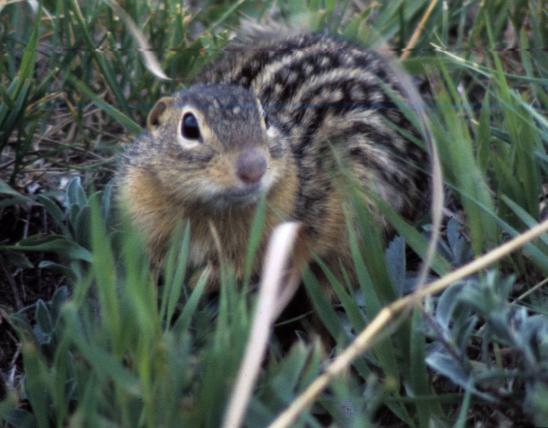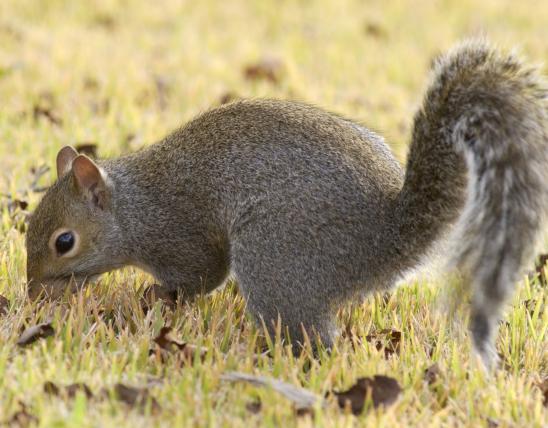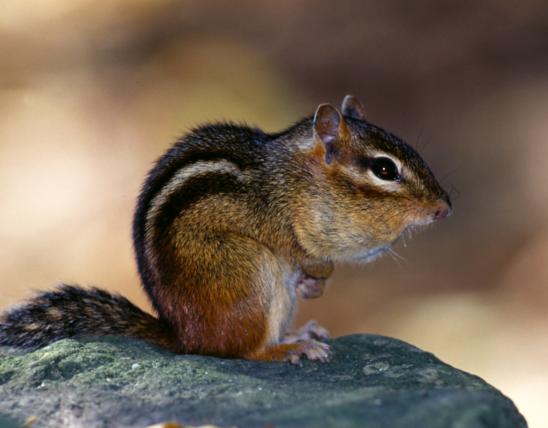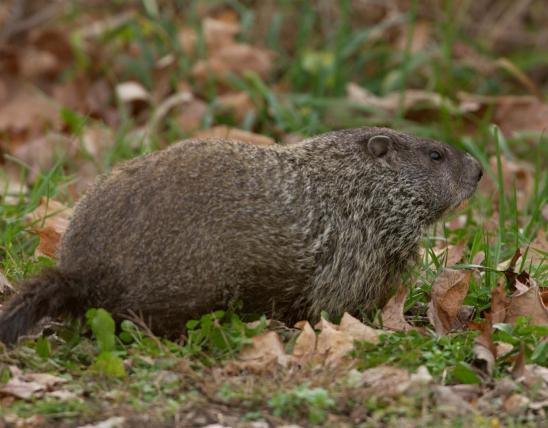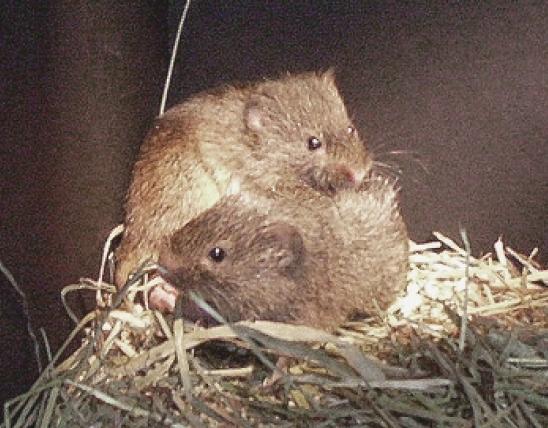
Franklin’s ground squirrel is a medium-sized mammal built somewhat similar to its close relative, the smaller and slenderer thirteen-lined ground squirrel. Franklin’s ground squirrel also resembles the eastern gray squirrel but has a shorter and less bushy tail, shorter and rounder ears, cheek pouches, longer and straighter claws, and a yellowish cast to the rump.
The overall color is rather uniformly brownish gray speckled with black, which gives a spotted or barred effect, particularly to the rump. The head is slightly darker than the rest of the upperparts and the sides are lighter. There is a yellowish tone to the rump. The underparts vary from yellowish white to gray or buff and the feet are dark gray. The tail is black and gray mixed, with black predominating toward the tip.
Franklin’s ground squirrels make remarkably clear, musical whistles that may easily be mistaken for bird calls. Both sexes may call, though males whistle more often than females. This call has given rise to another common name, whistling ground squirrel.
Total length: 14–16½ inches; the tail comprises about 4–6 inches of the total length. Weight: ¾–1½ pounds (individuals are heavier in fall than in spring; males are generally heavier than females).

Restricted to about the northern quarter of Missouri. Globally, the range is small, extending from central Canada into the north-central United States.
Habitat and Conservation
Occurs primarily in the borderland between woods and prairies; seldom uses either forests or strictly open prairies. It prefers tallgrass to midgrass prairies, with fencerows, wooded banks, gullies, and little-grazed sod. They also live along railroad rights-of-way and roadsides, which function as corridors linking islands of suitable habitat.
Franklin’s ground squirrel populations are declining, especially in the eastern portion of its range (including Missouri), due to destruction and fragmentation of its grassland habitat and to pesticide use. They may be abundant locally. Because they are rarely seen, their presence and abundance is often indicated when they are seen scampering across roads or dead along highways.
This species frequently selects a brushy bank or draw for its burrows, but in times of abundance, it may establish its home around farmyards, where it utilizes the shelter of shrubbery, trash piles, and buildings. The burrows lead to a den in the ground; they are similar to but larger, deeper, and better concealed than those made by the thirteen-lined ground squirrel.
The home range of an individual is about 100 yards in diameter. They live together in small colonies of 10–12 animals or more, which often stay in one locality for a year or part of a year and then move and set up a colony elsewhere.
Franklin’s ground squirrels are good tree climbers and can swim. They are notoriously curious and, after being alarmed and taking refuge in their burrows, frequently turn around immediately and look out.
Food
About 75 percent of the diet is plant-based, with animal material making up the rest. Plant foods include seeds, fruits, roots, and green vegetation of grasses, herbaceous plants, garden vegetables, and cultivated grain. Some of the cultivated grain is taken from seed heads in the field, but a great deal is from waste sources including grain spilled from trucks along roads. Animal foods consist of adult and larval insects, toads, frogs, mice, crayfish, fish, earthworms, young chickens and turkeys, small birds, bird eggs, mice, young rabbits, other ground squirrels, and some carrion. Water is taken on occasion, but succulent plants provide considerable moisture.
Status
Franklin’s ground squirrel is a species of conservation concern in Missouri. It once occurred in most of northern Missouri, but it has been declining and is not often seen. It is generally rare but may be common locally. Biologists have ranked it as vulnerable (to potentially imperiled) in our state, but it is secure across its North American range.
The disappearance of local populations of this species may not always be attributed to local extirpation but could result from this species’ tendency to move colonies from one area to another. If Missouri colonies do shift locations over time, this could account for some of the observed absence of the species from areas with past occupancy.
Life Cycle
Franklin’s ground squirrels are normally out and about only during broad daylight and often stay in their dens on windy, rainy, cloudy, or unseasonably cold days. They spend about 90 percent of their lives underground.
One of Missouri’s few mammals that truly hibernate, they accumulate a heavy layer of body fat as the summer progresses. Franklin’s ground squirrels are some of the first to enter hibernation in fall (between late August and early October) and last to emerge in spring (males in early April, females about a week later). Adults enter hibernation before young. Several animals may hibernate together. You can tell when they’re starting to emerge in spring when you hear their typical whistling.
Mating occurs soon after the females emerge from hibernation. Gestation lasts 28 days, and the single annual litter is born in May or June. A litter contains 4–11 young (usually 7). By about two weeks after birth, the young are fully furred. Between days 18 and 20, their eyes open and they start making their first shrill whistles. At about 30 days of age, they begin making short trips outside the burrow, and weaning occurs soon after that. The young stay with their mother for a few weeks but soon disperse. By fall, they are nearly as large as adults. They will be sexually mature by their first spring.
Life expectancy for females is 4–5 years; for males, it is 1–2 years.
Human Connections
Although Franklin’s ground squirrels cause some destruction to crops and some predation on wild ducks and domestic poultry, these losses are only important in localities or years where ground squirrels are abundant. If you are experiencing problems with these squirrels, contact a wildlife professional for advice, assistance, regulations, or special conditions for handling them.
Because control of this species is fairly difficult, the best suggestion is to let the population run its course, for sooner or later there will be a decline in abundance. Large numbers of ground squirrels will attract a diversity of wildlife, such as predatory raptors.
The total ecological impact of many individuals of the species makes them important members of our state’s natural habitats.
While birding is tremendously popular, it’s not common for people to go “mammal-watching.” However, the activities of Franklin’s ground squirrels can be enjoyed by interested observers because these animals are abroad in daylight and can be easily approached.
Franklin’s ground squirrel was first described to science in 1822, when it was named in honor of the British explorer Sir John Franklin. Franklin led two famous expeditions into the Canadian Arctic, in 1819 and 1825. Franklin’s ground squirrel was first collected during Franklin’s first expedition into Canada in 1819–1822. Franklin’s third expedition, seeking the Northwest Passage and begun in 1845, ended in disaster. His two wrecked ships were finally located in 2014 and 2016.
Ecosystem Connections
Foxes, coyotes, weasels, badgers, and snakes are probably the most important predators of Franklin’s ground squirrels because they can dig them out or seek them in the ground. Hawks and owls can capture them aboveground.
With their digging, these ground squirrels help aerate the soil, condition it for plant growth, and may attract earthworms, insects, and other soil-building organisms. Their plant-feeding and seed-storing activities influence the growth and distribution of certain plant species, which in turn may profoundly affect soil conditions and other plant and animal life. Their body wastes contribute to the organic structure of the soil, and their bodies provide food for predators. However, it is not the individual contribution but the sum total of all activities of many individuals of the species that make them important members of the ecosystem.
Their preference for tallgrass prairie habitat indicates that to maintain healthy Franklin’s ground squirrel populations, these habitats must be preserved, restored, and managed. Also, railroad rights-of-way can be managed in such a way to benefit Franklin’s ground squirrels.
Franklin’s ground squirrel is the only member of its genus. It used to be placed in the large Spermophilus genus of ground squirrels, but genetic studies have shown it deserves its own genus.


































